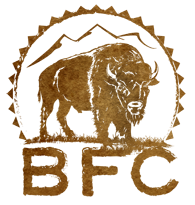Bloodied, orphaned yearling looking back on scene of the crime against nature that took his family from him. Photo by Joey Morin, BFC
West Yellowstone, MT.
In the early evening darkness of Wednesday, December 28, on a snow-packed two-lane highway, 13 wild bison mothers and yearlings met their unnatural fate at the hands of yet another semi-truck driver barreling down that stretch of U.S. Hwy 191 where bison-vehicle collisions have become all too frequent, thanks to Montana’s continuing refusal to lower the speed limit in accord with scientific recommendations. The orphaned yearling seen in the photo above was seen by BFC wolf biologist Joey Morin wan-dering aimlessly around the next day, missing a horn as well as his mother, his chances of surviving the winter now greatly diminished. If he is counted as a casualty, it would equal the highest body count ever for bison on this blood-stained stretch of highway.
Buffalo are highly social creatures with a close-knit family structure. So it matters a lot if a matriarch of a small pod is killed by a Mack truck. And these bison were all members of Yellowstone’s imperiled cen-tral herd, lineal descendants of the 23 survivors of the United State’s attempt to exterminate the species altogether in the 19th Century, part of its program of genocide against America’s Indigenous Tribes. Like the Tribes themselves, the American Buffalo is still here.
While the overall population of Yellowstone’s wild bison is approaching 6,000, the central herd has been in decline for some time now, trending down towards one thousand total, and making this particular mass killing a real kick in the gut to those of us with Buffalo Field Campaign who had been shepherding them around Horse Butte over the holiday season.
We here at Buffalo Field Campaign are determined to make this tragedy matter. Because it doesn’t have to be this way.
While these bison-vehicle collisions have become inevitable, they are easily avoidable. It's just a matter of people valuing buffalo enough to provide them with safe passage on their migratory routes onto Horse Butte, just to the west of Yellowstone National Park.
Seven of every ten bison-vehicle collisions, including this one, occur along a seven-mile stretch of U.S. Highway 191 where the Madison River crosses the road.
Is it too much to ask for people to slow down for seven miles in order protect our National Mammal?
Death Highway
Highway 191 is snow-packed most of the winter, and is heavily utilized by commercial trucking compa-nies. The speed limit on Hwy 191 is 75 mph, 65 for trucks. Further on up the road, traffic passes through
the National Park itself, and the speed limit is reduced to 55 mph at the Park’s insistence — though 55 is still excessive for safe wildlife passage across dark roads at night.
According to experts at the Western Transportation Institute, at Montana State University, a night-time driver traveling over 45 miles per hour does not have time to safely react when a bison or other large mammal appears in their headlights. Bison are especially difficult to see, as their eyes do not reflect light like other ungulates. As one can imagine, it is even more difficult to bring a semi-truck and trailer to a sudden stop. In this instance, the driver plowed right through a large, migrating herd of our National Mammal near the Madison River crossing to Horse Butte.
So far this season, 19 bison, four moose and a grizzly bear have died in collisions on local highways near the town of West Yellowstone. Spring is actually the season when the risk of collisions on these roads is highest, and this year’s high toll coincides with an early migration out of the Park that may be attributable to the unusual flooding experienced last summer.
Congress recently made $350M available for wildlife crossings. A 2012 study prepared for the Western Transportation Institute by research assistants at the MSU College of Engineering found that “bison-vehi-cle collisions on US 191 pose a serious traffic safety threat” - especially at the at the Madison River cross-ing, a migratory path that hundreds of bison travel every winter and spring.
BFC’s Executive Director James Holt, an environmental scientist from the Nez Perce Tribe, witnessed the bloody accident scene Thursday morning, and feels strongly that the shocking death toll should serve as a wake-up call for both Montana and the federal stewards of Yellowstone bison. “There is no excuse for this kind of carnage,” Holt said. “Montana needs to effectively lower the speed limit now for this bloody 7-mile stretch of road, and both the Park Service and the Forest Service need to strongly advocate for world’s first dedicated Buffalo Bridge to be built at the Madison River crossing,” Holt said.
“How can we spend $350M in this country on wildlife bridges, and not include safe passage for Yellow-stone bison?” Holt asked. “How is it that Canada’s oldest national park, Banff, can boast of 38 wildlife tunnels and six wildlife bridges just to the north of us, while the world’s first national park here in Yel-lowstone has zero?” he added. “Let this tragic incident be the catalyst for we humans to do right by our Buffalo relatives.”
The Solution is Simple
The 2012 WTI study, by Ashleigh Dupree and Isabella DiMambro, found that more than half of all bison-vehicle collisions occur at the Madison River crossing, between mile markers 2.0 and 5.0. The next high-est highway segment, accounting for another 17% of all collisions in the decade covered by the study, is just up the road near Duck Creek, between mile markers 7.0 and 9.0. According to the study’s conclusions, “Duck Creek is a bison migratory path as well as being habitat of other native species that are found in Yellowstone National Park and the Gallatin National Forest.” Cumulatively, then, the study found 68% of bison-vehicle collisions occur in the seven-mile stretch from Duck Creek to the Madison River crossing, between mile markers 9.0 and 2.0.
The Buffalo Field Campaign works tirelessly to alert drivers when bison are in the road, avoiding count-less collisions over the years, but cannot be on the roads at nighttime during the winter out of concern for the safety of its volunteers — though we are on call 24/7 with both the snowplow drivers and the local police dispatcher. During the spring and summer months, when the risk of bison-vehicle collisions is at its highest, BFC conducts night patrols.
BFC is not, however, the designated stewards of our National Mammal. We’re just doing damage control, thanks to our many dedicated volunteers. We’ve been pleading with Montana’s Department of Transpor-tation for reduced speed limits for over a decade now, and thousands of our supporters have written letters to MDOT urging it to take action (you can, too). After this latest tragedy, we’re now appealing to Park Service and Forest Service officials to advocate for a Buffalo Bridge along with interim traffic-calming methods.
You can add your voice by signing our petition here.
Let us honor, respect and protect our National Mammal, the American Buffalo, that millions of people from around the world travel to experience in its natural habitat every year. Let’s build the world’s first dedicated Buffalo Bridge to show how much we care.
ORPHAN UPDATE: People have been asking if something couldn't be done for the orphaned buffalo yearling. BFC observed the orphan the day after the crash, and not since. Two days later, we ran into FWP personnel out on snowmobiles, and they also had not seen it. This likely means it headed back into the Park. Pods of bison regularly adopt orphaned yearlings, and we would add that this one was not limping or showing other signs of the accident other than on the right side of his head. As always, we deeply appreciate everyone's concern.
~ Tom Woodbury is Director of Communications for the Buffalo Field Campaign, This email address is being protected from spambots. You need JavaScript enabled to view it.










